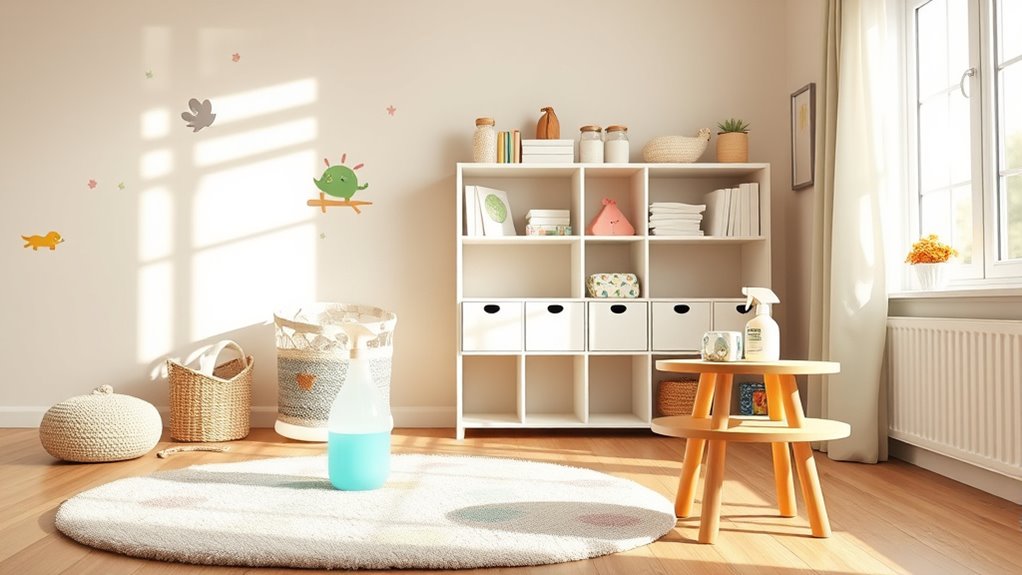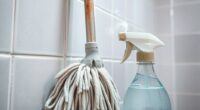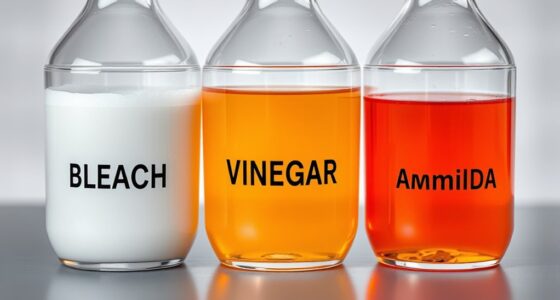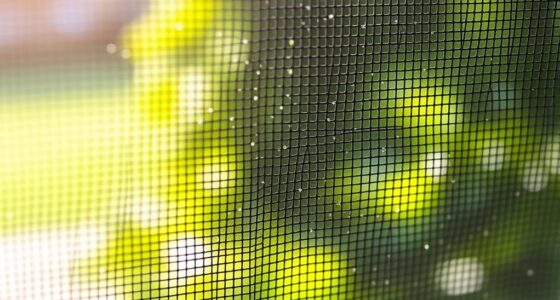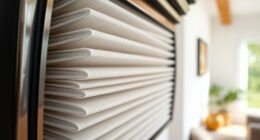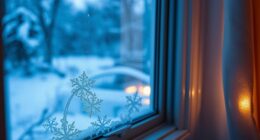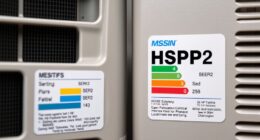To keep nurseries and playrooms safe, opt for natural, non-toxic cleaning products made with plant-based ingredients, free from harsh chemicals, fragrances, and dyes. Look for certified labels from trusted organizations like EPA or Green Seal to guarantee safety. Consider eco-friendly disinfectants, DIY solutions like vinegar or baking soda, and store supplies securely out of children’s reach. Managing these practices helps create a healthy environment—continue exploring for more tips on maintaining child-safe spaces.
Key Takeaways
- Choose natural, non-toxic cleaning products free from harsh chemicals, fragrances, and dyes to ensure safety for children.
- Look for certifications from EPA, USDA, or Green Seal to verify product safety and non-toxicity.
- Use eco-friendly disinfectants made from plant-based ingredients and natural stain removers like baking soda, vinegar, and lemon juice.
- Make DIY cleaning solutions with biodegradable soaps, diluted vinegar, or tea tree oil to avoid synthetic chemicals.
- Store cleaning supplies securely in childproof cabinets and clearly label containers to prevent accidental access.
Understanding Child-Friendly Cleaning Ingredients
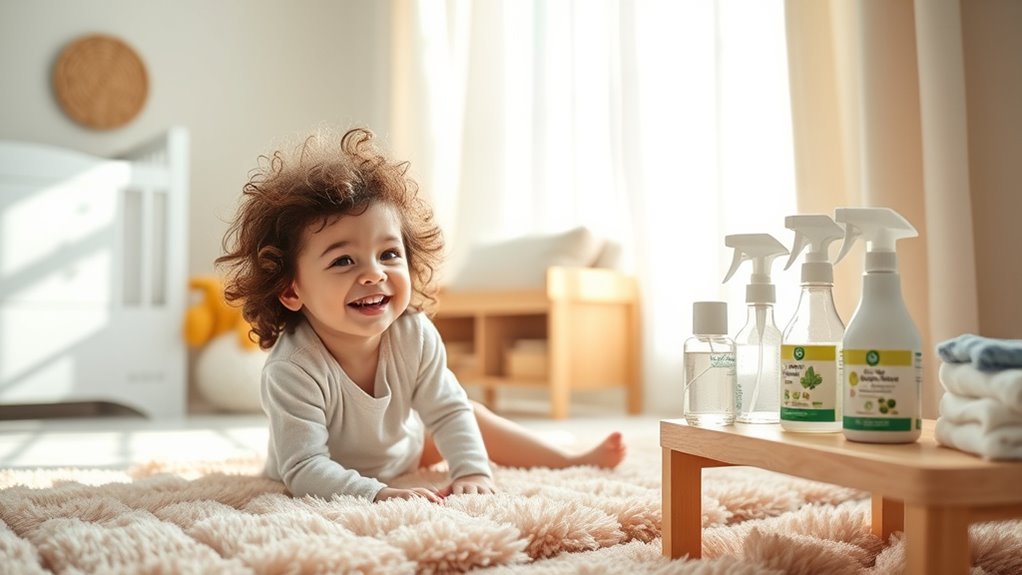
When choosing cleaning products that are safe for children, understanding their ingredients is essential. Some children have chemical sensitivities that can trigger reactions like rashes, respiratory issues, or other allergic responses. To support allergen avoidance, opt for products made with natural, non-toxic ingredients that are free from harsh chemicals, fragrances, and dyes. Look for plant-based cleaners or those labeled as hypoallergenic, as these are less likely to cause irritation. Reading labels carefully helps you identify ingredients that might pose risks to sensitive skin or respiratory health. Incorporating personal development principles such as mindfulness and goal setting can help parents stay informed and make better choices for their child’s environment. By selecting child-friendly cleaning products with safe ingredients, you create a healthier environment and reduce the chances of allergic reactions or discomfort for your little ones.
Recognizing Safe Certifications and Labels
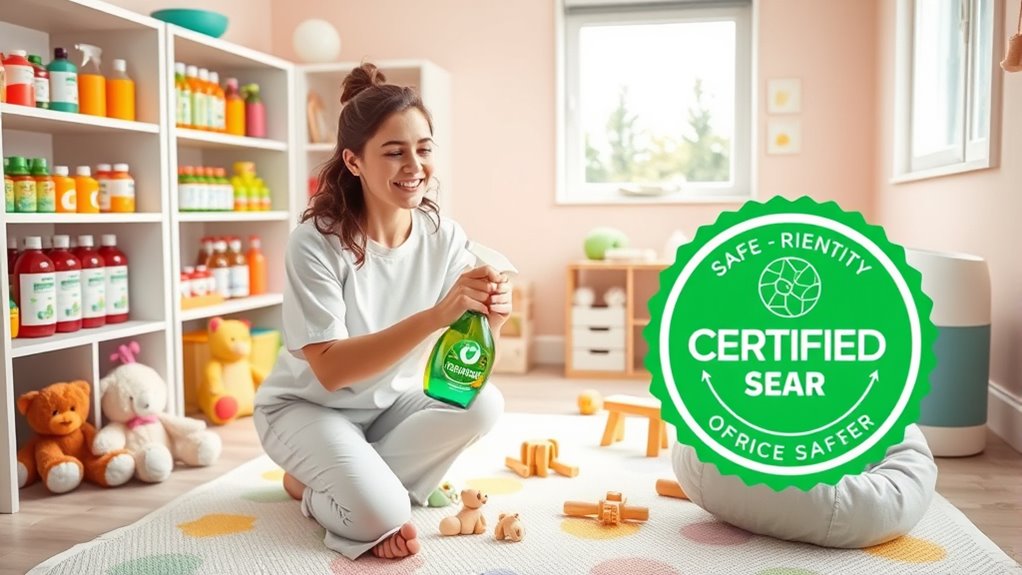
Recognizing safe certifications and labels on cleaning products helps you quickly identify options that meet safety standards for children. Certification standards are established by reputable organizations to ensure products are non-toxic and safe for kid-friendly environments. Look for labels from trusted agencies like the EPA, USDA, or Green Seal, which verify that products meet strict safety criteria. Label interpretation is key; read labels carefully to spot certifications and avoid misleading claims. Certified products often display recognizable logos or seals that confirm they adhere to safety standards. By understanding these certifications and labels, you can confidently select cleaning supplies that prioritize your child’s health and safety, reducing the risk of exposure to harmful chemicals in nurseries and playrooms. Additionally, necessary cookies and other safety-related information help you maintain a secure environment for your children.
Natural and Eco-Friendly Cleaning Alternatives
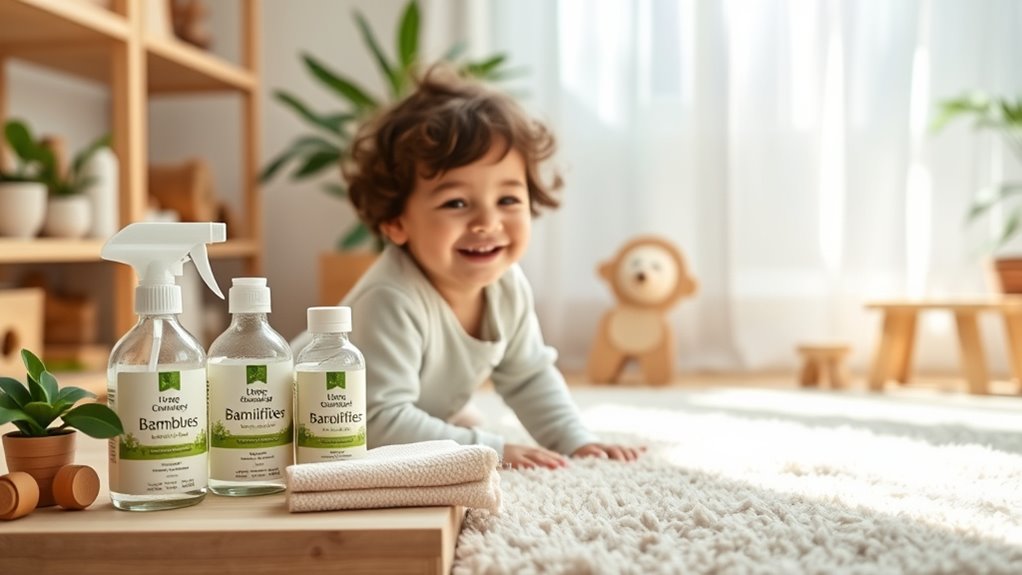
Choosing cleaning products with safety certifications is a great step, but you can go even further by exploring natural and eco-friendly alternatives. Eco friendly disinfectants made from plant-based ingredients effectively sanitize surfaces without harsh chemicals, reducing risks for children. Natural stain removers, like baking soda, white vinegar, and lemon juice, tackle spills and stains safely while avoiding toxic fumes. These alternatives are biodegradable, non-toxic, and gentle on little ones’ skin. Using them regularly can help maintain a clean environment without compromising safety. Plus, many eco-friendly disinfectants and natural stain removers are readily available at stores or can be part of your routine cleaning kit. Incorporating certified eco-friendly products can further ensure your home remains safe and healthy for your kids. By choosing these options, you protect your kids’ health and contribute to a healthier planet.
DIY Cleaning Solutions for Nurseries and Playrooms
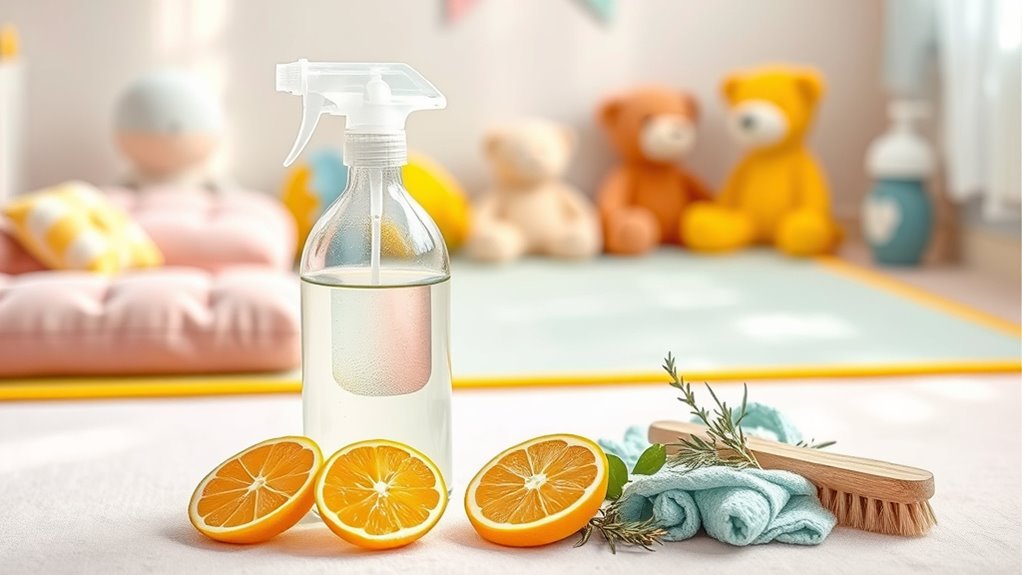
Ever wondered how to create effective, safe cleaning solutions right in your own home? You can easily make kid-safe cleaners using non toxic disinfectants and biodegradable soaps. Mix water with a small amount of biodegradable soap to clean surfaces gently yet effectively. For disinfecting, combine water with a natural, non toxic disinfectant like diluted vinegar or tea tree oil, ensuring no harsh chemicals touch your child’s environment. These DIY solutions are free from synthetic fragrances and harmful chemicals, making them safe for nurseries and playrooms. Plus, they’re budget-friendly and environmentally friendly. When cleaning, always test a small area first to prevent any damage. Additionally, choosing AI-powered cleaning tools can help maintain a hygienic environment more efficiently. With these simple recipes, you’ll maintain a clean, safe space where your little ones can explore and grow without exposure to toxic substances.
Tips for Proper Storage of Cleaning Supplies
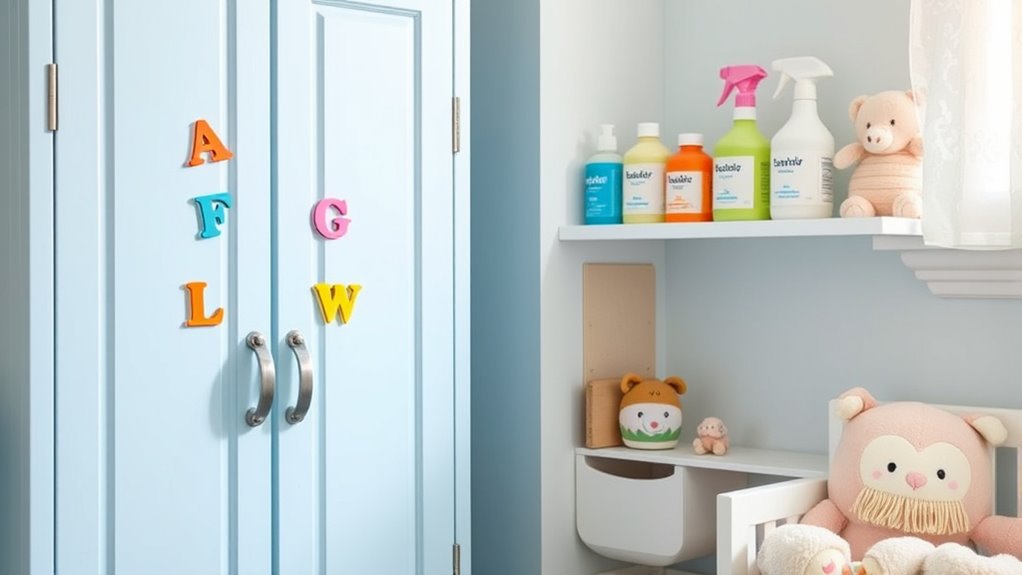
Keeping your DIY kid-safe cleaning solutions properly stored is key to maintaining a safe environment for your little ones. Use childproof cabinet locks to secure all cleaning supplies, preventing curious kids from accessing them. Label all storage containers clearly with their contents to avoid accidental misuse or confusion. Store cleaning supplies on high shelves or in locked cabinets out of children’s reach. Keep hazardous substances separate from toys and food items to reduce risks. Regularly check that childproof locks remain secure and labels stay visible. Consider using color-coded containers for different cleaning solutions, which helps quickly identify their purpose. Proper storage not only keeps harmful substances away from children but also promotes a safer, more organized play and nursery area. Additionally, understanding outdoor kitchen plans and guides can inspire you to create safe outdoor spaces that complement nursery safety measures.
Regular Cleaning Routines to Maintain a Toxin-Free Environment
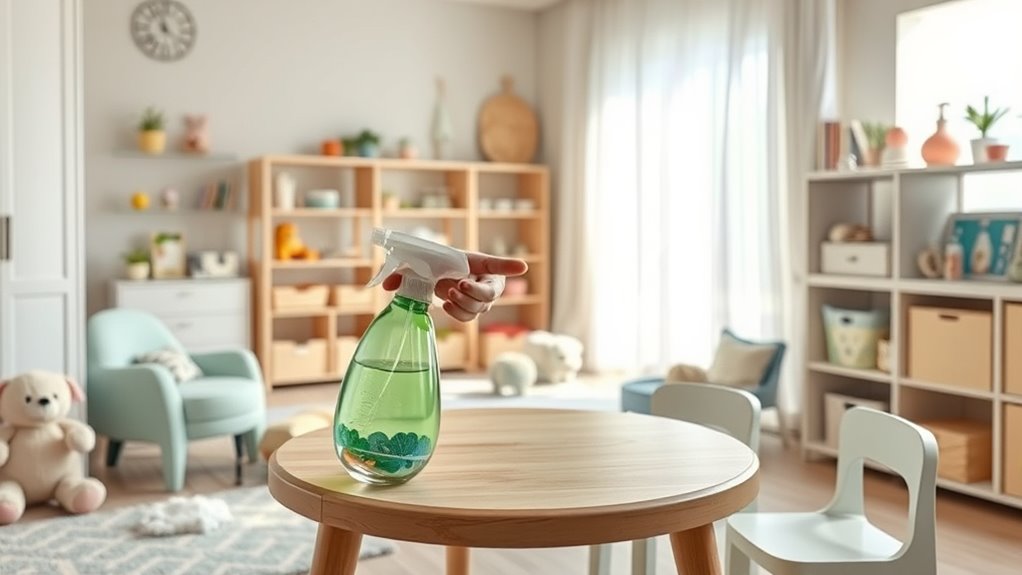
Establishing a consistent cleaning routine is essential for maintaining a toxin-free environment in your home. Create a regular cleaning schedule that includes daily, weekly, and monthly tasks to prevent buildup of dust, dirt, and germs. Use child-proof storage for cleaning supplies, so harmful substances stay out of reach. Wipe surfaces frequently with non-toxic cleaners, especially in play areas and nurseries. Vacuum carpets and rugs regularly to reduce allergens. Pay special attention to high-touch areas like doorknobs, light switches, and toys. Regularly checking and calibrating your projector’s color accuracy ensures optimal image quality and a safe viewing experience. Consistency is key; sticking to your cleaning schedule helps eliminate toxins and keeps your environment safe for your kids. By maintaining routine cleanliness and securing cleaning products, you create a healthier, safer space for your children to explore and grow.
Educating Caregivers and Parents on Safe Cleaning Practices
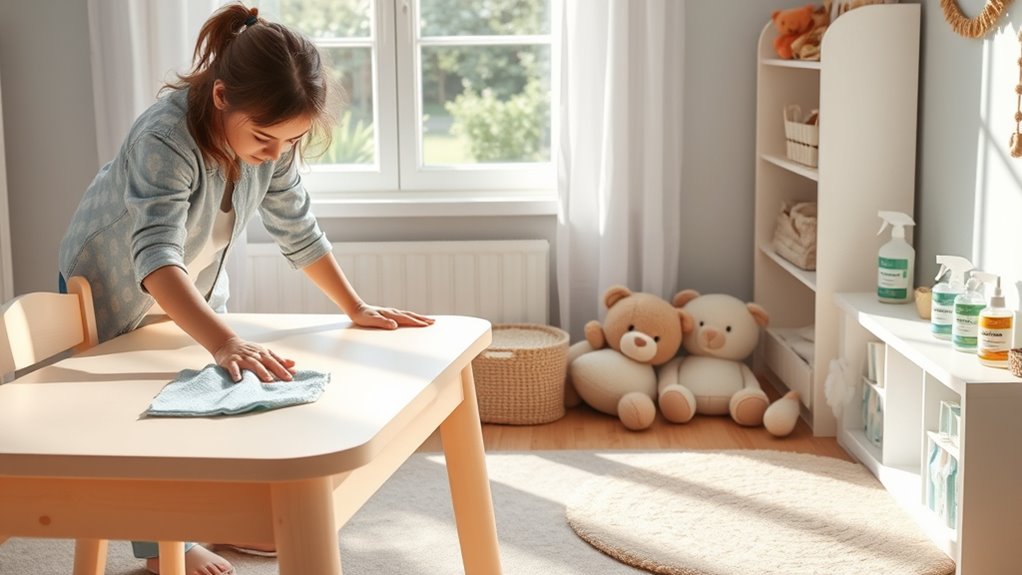
How can caregivers and parents guarantee they’re using safe cleaning practices around children? Start by focusing on toxic ingredient avoidance. Read labels carefully and choose products free from harmful chemicals. Educating yourself about common toxins helps you make informed decisions. Always look for child proof container labeling to prevent accidental ingestion or misuse. Teach children that cleaning products are not toys and keep them out of reach. Share this knowledge with other caregivers and family members to create a consistent safety approach. Regularly update your understanding of safe cleaning options and stay informed about new products designed for kid-friendly environments. Being aware of artistic influences and the cultural significance of materials like butter can inspire creative, safe, and natural cleaning solutions that respect traditional practices. By staying vigilant and educated, you ensure a safer space where children can play and grow without exposure to dangerous chemicals.
Frequently Asked Questions
Are There Any Common Household Items to Avoid in Nurseries?
You should avoid using common household items with harsh chemicals or toxic fumes in nurseries. These include bleach, ammonia, and air fresheners, which can irritate your child’s skin and lungs. Opt for natural cleaners like vinegar and baking soda instead. Always read labels carefully, and steer clear of products with strong fragrances or harmful ingredients. Your goal is a safe, healthy environment for your little one, free from dangerous fumes and chemicals.
How Often Should Nursery Cleaning Products Be Replaced?
You should replace nursery cleaning products every three to six months to guarantee safety. Studies show that many cleaning products lose effectiveness or develop bacteria over time, impacting your cleaning schedule. Check the product shelf life regularly, and if it’s past the date or smells off, swap it out. This keeps your nursery safe, clean, and free from harmful residues, giving you peace of mind with your little ones.
Can Children Help With Cleaning Tasks Safely?
Yes, children can help with cleaning tasks safely when you provide age-appropriate tasks and supervise them closely. You should always supervise your kids to ensure they use safe cleaning tools and understand proper techniques. Assign simple chores like dusting or wiping surfaces, but avoid handling harsh chemicals. By guiding them and setting clear boundaries, you teach responsibility while keeping them safe during cleaning routines.
What Are Signs of Allergic Reactions to Cleaning Products?
Think of allergic reactions to cleaning products as warning sirens in your home. You might notice skin rashes, sneezing, or watery eyes—these are clear cleaning product indicators. Allergic symptom awareness is key; watch for difficulty breathing or swelling, which require immediate attention. If your child shows these signs after cleaning, stop using the product and consult a healthcare professional to prevent further reactions.
Are There Any Specific Cleaning Methods for Soft Toys and Bedding?
For soft toy sanitization, wash them regularly using gentle, kid-safe detergents and follow bedding washing guidelines to keep everything clean. Use hot water when appropriate and dry thoroughly to eliminate germs. Vacuum plush toys frequently, and consider air-drying or tumble drying on low heat. This routine helps prevent bacteria buildup and keeps your nursery safe and hygienic for your little one.
Conclusion
By choosing child-safe cleaning products and following best practices, you create a healthier space for little ones to explore and grow. For example, Sarah switched to natural cleaners in her nursery and noticed her baby’s skin clearing up. Staying informed about labels, storing supplies safely, and involving caregivers guarantees everyone plays a role in maintaining a toxin-free environment. Together, these steps make your nursery a safe, happy haven for your children.
